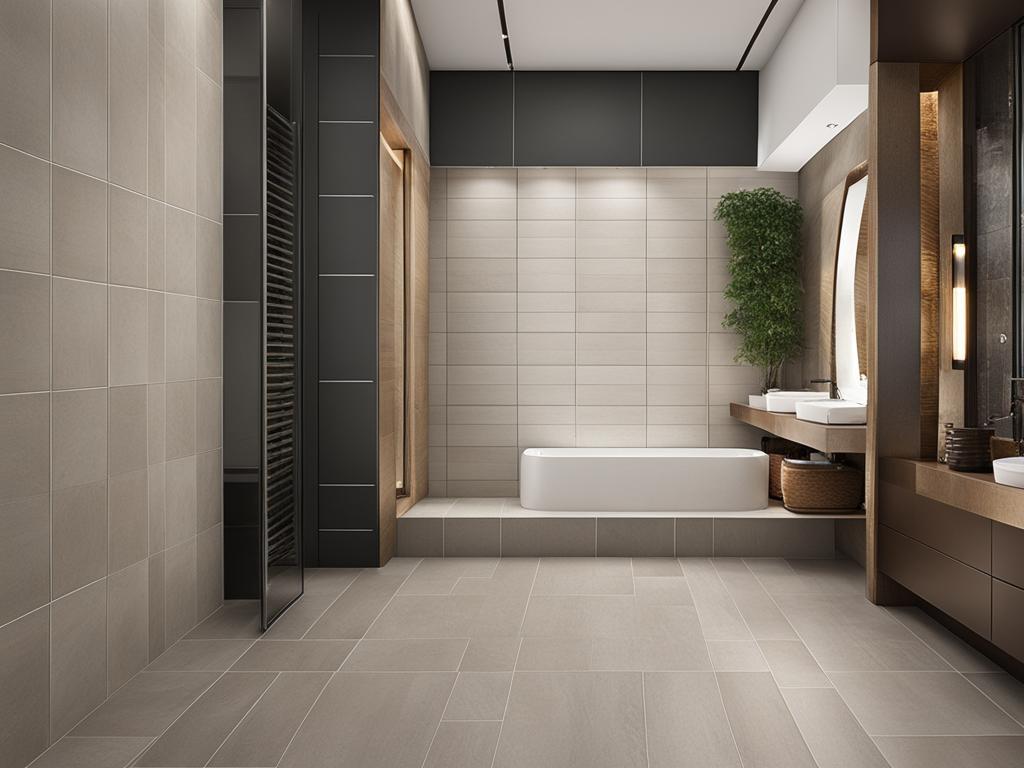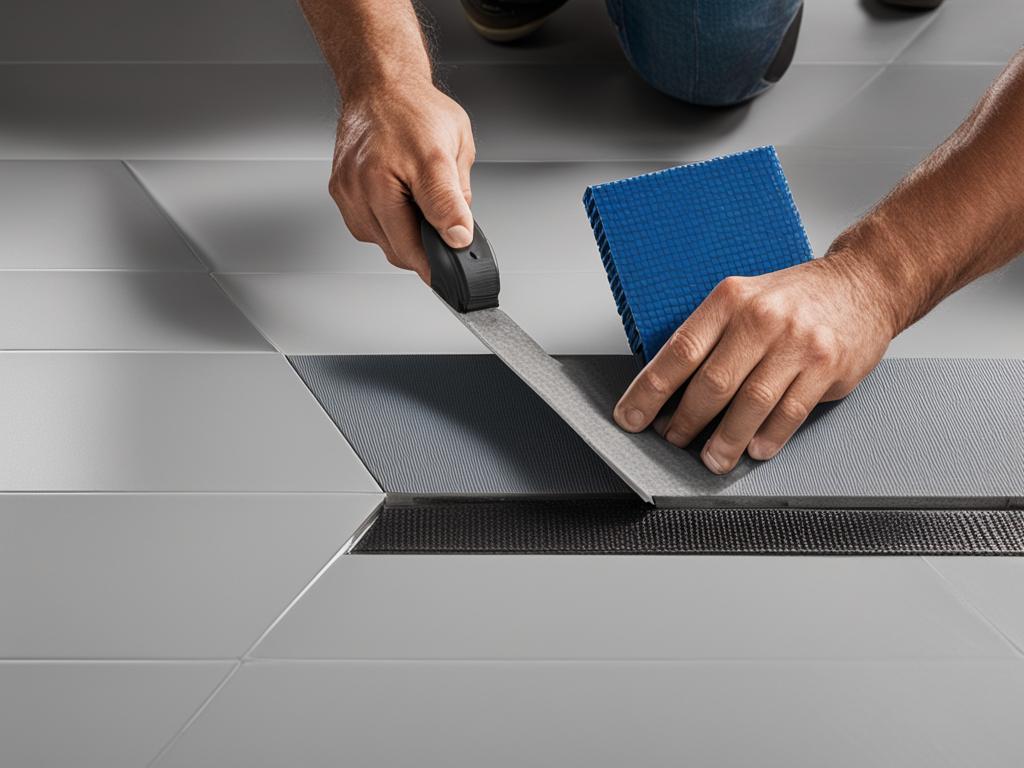Durock and Hardibacker are two popular options when it comes to tile backer boards. These cement boards provide the necessary support for tiles and protect against moisture damage, ensuring a long-lasting and sturdy tiled surface. Understanding the differences between Durock and Hardibacker can help you make an informed decision for your tile installation project.
Hardibacker is composed of cellulose fibers, crushed sand, and Portland cement, making it a lightweight option that is ideal for indoor use. On the other hand, Durock is made of Portland cement aggregate and glass mesh, offering versatility for both interior and exterior applications. Both boards are mold-resistant and provide a solid foundation for your tiled surfaces.
When choosing between Durock and Hardibacker, consider factors such as the type of installation (such as shower, flooring, or bathroom), the specific requirements of your project, and the tiles being used. By understanding the key differences between the two, you can select the best tile backer board that meets your needs and ensures the success of your tile installation.
Key Takeaways:
- Durock and Hardibacker are popular tile backer board options that provide support for tiles and prevent moisture damage.
- Hardibacker is lighter and more suitable for indoor use, while Durock is versatile and can be used for both interior and exterior applications.
- Both boards are durable, mold-resistant, and offer a solid foundation for tiled surfaces.
- Durock is more impervious to mold and mildew, while Hardibacker is more suitable for soft materials like vinyl and porcelain.
- Consider factors such as the specific requirements of your project and the type of tiles being used when choosing between Durock and Hardibacker.
Key Differences in Weight and Density
When comparing Durock and Hardibacker, one of the key factors to consider is their weight and density. These properties play a significant role in the ease of installation and the load capacity they can support.
Hardibacker, composed of cellulose fibers, crushed sand, and Portland cement, is relatively lighter than Durock. This lightweight composition makes it more manageable during the installation process and reduces the overall load on the structure. In fact, compared to other cement boards, Hardibacker has a lower density, making it a popular choice for many construction projects.
Durock, on the other hand, is constructed with Portland cement aggregate and glass mesh. While it is also relatively lightweight, the weight and density difference between Durock and Hardibacker is not significant. The specific dimensions and thickness of the board can influence its overall weight. However, the inclusion of glass mesh in Durock gives it a slightly heavier structure when compared to Hardibacker.
Durock vs. Hardibacker Weight and Density Comparison:
| Cement Board | Weight (per square foot) | Density (pounds per cubic foot) |
|---|---|---|
| Hardibacker | Variable, depending on thickness and dimensions | Lower density compared to other cement boards |
| Durock | Variable, depending on thickness and dimensions | Slightly higher density due to the presence of glass mesh |
As seen in the comparison table above, both Durock and Hardibacker offer lightweight options for tile backer boards. The weight and density differences primarily lie in the specific dimensions, thickness, and composition of the board. However, it is worth noting that these variances are not substantial.
When selecting between Durock and Hardibacker, it is crucial to consider the load capacity requirements of your project and consult the manufacturer’s guidelines for the optimal choice.
Suitable Applications for Hardibacker and Durock
When it comes to choosing between Hardibacker and Durock, it’s essential to consider their suitability for different applications. While both boards offer excellent support for tiles, certain factors determine their ideal usage.
Hardibacker:
Hardibacker is primarily designed for indoor spaces, making it an excellent choice for tile installations in areas such as kitchens, showers, and bathrooms. Its high water resistance ensures durability and prevents moisture damage in these moisture-prone environments. However, Hardibacker is not recommended for exterior and open-air use due to its composition and potential exposure to harsh outdoor conditions.
Durock:
Durock, on the other hand, is a versatile option that can be used for both interior and exterior applications. It provides a solid foundation for tile substrates in various areas, including floors, countertops, and wet locations like showers and bathrooms. Durock’s compatibility with exterior use makes it suitable for projects that require tiling in outdoor spaces.
While Durock and Hardibacker offer different application possibilities, it’s crucial to consult the manufacturer’s guidelines and recommendations for specific project requirements and proper installation techniques.

Ease of Cutting and Messiness
When it comes to cutting, Durock emerges as the easier option compared to Hardibacker. Even with basic tools like utility knives or carbide-tipped scoring blades, Durock can be cut with relative ease. This makes it convenient for both professionals and DIY enthusiasts who want to achieve precise cuts for their tile installations.
However, it’s important to note that working with Durock can get a bit messy during the installation process. This is primarily due to the presence of glass fibers in its composition. As the board is cut or manipulated, these fibers can cause loose particles and debris, resulting in a potentially untidy work environment.
The Messiness Factor
“Cutting Durock may create a bit of a mess due to its glass fiber content, but with careful handling and proper cleanup, this can be easily managed.”
On the other hand, Hardibacker offers a solution for those who prefer a tidier work environment. Its lighter weight and EZ Grid pattern make it incredibly manageable during installation. The EZ Grid pattern serves as a visual guide, helping installers achieve straight and accurate cuts with clean edges. This feature not only simplifies the cutting process but also reduces the chances of creating a mess.
Choosing between Durock and Hardibacker in terms of cutting and messiness ultimately depends on personal preferences and priorities. While Durock excels in ease of cutting, it may require extra caution when dealing with potential mess. In contrast, Hardibacker’s design prioritizes simplicity and cleanliness, providing a smoother installation experience.
Durability, Mold Resistance, and Scratches
When it comes to durability, both Hardibacker and Durock are reliable choices that provide excellent protection against moisture damage. These cement boards are designed to withstand the test of time, ensuring a long-lasting foundation for your tiled surfaces.
One key factor to consider is the mold resistance of these boards. While both Hardibacker and Durock offer resistance to mold and mildew, Durock is known to be more impervious to fungal growth. This can be attributed to the inclusion of fiberglass in Durock boards, which not only enhances its durability but also helps prevent cracks and the development of mold.
However, it’s worth noting that the rough surface of Durock can potentially cause scratches and wear on soft materials such as vinyl and porcelain. This is something to keep in mind if you’re planning to use these materials in your project. On the other hand, Hardibacker’s smoother texture makes it more suitable for avoiding scratches, making it a favorable choice for projects where soft materials are involved.
| Durability | Mold Resistance | Scratch Resistance | |
|---|---|---|---|
| Hardibacker | Excellent | Resistant | High |
| Durock | Excellent | More impervious | Potential for scratches on soft materials |
As seen in the table above, both Hardibacker and Durock offer excellent durability and mold resistance. However, if scratch resistance is a crucial factor for your project, especially when working with soft materials, Hardibacker’s smoother surface may be the better option.

Fire Resistance and Noncombustibility
When it comes to fire resistance, both Hardibacker and Durock cement board products have undergone rigorous testing to ensure their safety. Hardibacker is specifically designed to be fire-resistant and remains noncombustible when tested to ASTM E 136 standards. Similarly, Durock cement board products also meet the ASTM Standard E136 for noncombustibility. Rest assured, both boards are engineered to resist combustion and provide reliable protection against fire hazards.
One advantage that Durock holds in terms of fire resistance is its composition. Durock includes glass fibers, which enhance its ability to withstand high temperatures without breaking down or igniting. This added strength gives Durock an edge when it comes to fire resistance, making it an excellent choice for projects where fire safety is a top priority.
To reinforce their commitment to safety, both Hardibacker and Durock are asbestos-free. This ensures that the use of these cement boards poses no health concerns related to asbestos exposure.
| Hardibacker | Durock | |
|---|---|---|
| Fire Resistance | Designed to be fire-resistant | Meets ASTM Standard E136 for noncombustibility |
| Noncombustibility | Remains noncombustible when tested to ASTM E 136 | Meets ASTM Standard E136 for noncombustibility |
| Advantages | – Fire-resistant composition – Suitable for fire-prone areas |
– Glass fibers enhance fire resistance – Withstands high temperatures |
As the table illustrates, both Hardibacker and Durock demonstrate fire resistance and noncombustibility, making them reliable choices when it comes to protecting your project from potential fire hazards and ensuring the safety of occupants.
Conclusion
After considering the specific requirements of your project, the environment, the type of tiles, and the installation method, it is clear that both Durock and Hardibacker have their strengths. Hardibacker offers excellent moisture resistance and is particularly suitable for DIY projects due to its user-friendly installation process. On the other hand, Durock’s strength and versatility make it a great choice for a wide range of indoor and outdoor applications.
If you are looking for a backer board that is easy to handle and install, especially for areas like kitchens, showers, and bathrooms, Hardibacker is a reliable option. Its lighter weight and smoother surface make it suitable for avoiding scratches on delicate materials like vinyl and porcelain. Plus, it is highly resistant to mold and mildew, ensuring a hygienic environment for your tiled surfaces.
However, if you require a more robust and versatile option, Durock is the way to go. Not only does it offer excellent durability and moisture resistance, but it is also impervious to mold and mildew. Its ability to be used both indoors and outdoors opens up endless possibilities for your tile projects. Whether you’re tiling floors, countertops, or wet areas, Durock can provide a solid foundation that will stand the test of time.
Ultimately, the final decision between Durock and Hardibacker comes down to your specific needs, preferences, and budget constraints. Consider the unique requirements of your project and weigh the advantages of each board. By doing so, you can confidently choose the tile backer board that best suits your needs and ensures the success of your tiling project.
FAQ
What are the key differences between Durock and Hardibacker?
Durock is made of Portland cement aggregate and glass mesh, while Hardibacker is made of cellulose fibers, crushed sand, and Portland cement. Durock is more impervious to mold and mildew, while Hardibacker is more suitable for soft materials like vinyl and porcelain.
Which backer board is lighter and more suitable for indoor use?
Hardibacker is lighter than Durock due to its composition with cellulose fibers, crushed sand, and Portland cement. It is more suitable for indoor use, particularly for tile installations in areas like kitchens, showers, and bathrooms.
Can Durock be used for both interior and exterior applications?
Yes, Durock is versatile and can be used for both interior and exterior applications. It can be used as a tile substrate on floors, countertops, and wet locations. However, it is important to consult the manufacturer’s guidelines for specific project requirements and proper installation.
Is it easier to cut Durock or Hardibacker?
Durock is easier to cut compared to Hardibacker, even using common tools like utility knives or carbide-tipped scoring blades. However, the handling and cutting of Durock can create a messy work environment due to the presence of glass fibers in its composition. Hardibacker, being lighter and having an EZ Grid pattern, offers convenience during installation and provides a visual guide for straight and accurate cuts with clean edges.
Are Durock and Hardibacker both durable and mold-resistant?
Yes, both Durock and Hardibacker offer durability and protection against moisture damage. They are resistant to mold and mildew. Durock, however, is considered more impervious to fungal growth. The inclusion of fiberglass in Durock boards helps prevent cracks and improves durability. However, the rough surface of Durock can potentially cause scratches and wear on soft materials like vinyl and porcelain. Hardibacker, being lighter and smoother, is more suitable for avoiding such issues.
Are Durock and Hardibacker fire-resistant?
Yes, both Hardibacker and Durock cement board products meet ASTM Standard E136 for noncombustibility. They are designed to be fire-resistant and safe from health concerns related to asbestos. The inclusion of glass fibers in Durock enhances its ability to withstand high temperatures without breaking down or igniting, giving it an advantage in terms of fire resistance.
How do I decide between Durock and Hardibacker?
When deciding between Durock and Hardibacker, consider factors like the specific requirements of your project, the environment where the board will be installed, the type of tiles being used, and the installation method. Hardibacker offers moisture resistance and user-friendly installation, making it a great choice for DIY projects. Durock’s strength and versatility make it suitable for various indoor and outdoor applications. Ultimately, the choice between the two depends on your specific needs, preferences, and budget constraints.
